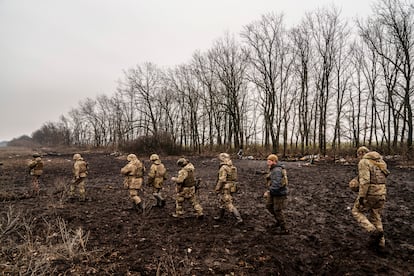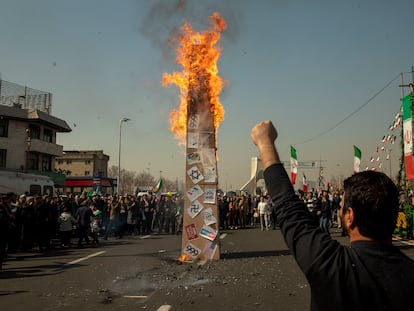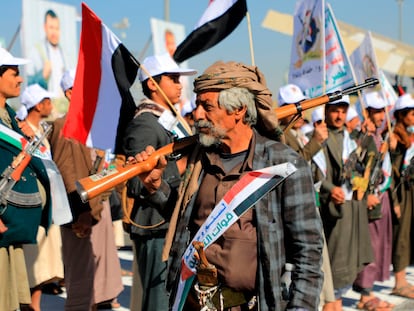How the world has changed with the war in Ukraine
War is the greatest and most brutal engine of change. And war calls for war; especially when there is no longer a superpower to prevent it. If Russia can mobilize against Ukraine, so can China against Taiwan, Azerbaijan against Armenia, and Israel against Gaza
On February 24, 2022 the world suddenly looked very different for generations of young Europeans, yet the reason why is as old as time itself. War had returned to the Old Continent, a place it had ravaged for centuries, and after 77 years of peace, almost no one remembered it.
Before long there were images of modern cities being bombed, endless columns of armored vehicles, masses of soldiers advancing, retreating, or digging trenches among the urban ruins and in the fortifications of the battlefields. There were massacres of civilians, subway stations and basements full of families, long lines of refugees, and bloody images of wounded and mutilated soldiers and civilians in hospitals.
Europe has always had wars: three decades ago the Balkans were torn apart by interethnic clashes, and there has been fighting in Ukraine’s Donbas region since 2014, but these conflicts have been limited and even contained. A new kind of hybrid warfare has emerged. The world has seen asymmetrical terrorist attacks, invasions of entire countries with hardly any resistance, systematic aerial bombardments, selective assassinations, and the counterinsurgency of occupying powers against local guerrillas.
But the novelty of old-fashioned warfare that returned in the early hours of February 24, 2022, was something different, yet it was familiar and unrecognizable at the same time. It was unreal. One might even say it came from films and television in a mixture of old and new images of horror. And that is because its return has occurred on the continent where the most wars in human history have been fought, and perhaps the only place where war lay completely forgotten and discarded as an instrument of conflict resolution.
The figure of the ancient and ferocious warrior monster has returned. The notable philosopher Raymond Aron used this image in his pioneering 1951 book The Century of Total War in his study of the 20th-century conflicts. It is a hyperbolic war, dominated by industry and technology, and involves entire societies. It puts civilians on the front line in a brutal existential clash between two countries that wastes lives, wealth, and even the future. And political leaders get caught up in a bloody auction in pursuit of victory at all costs.
The unexpected arrival of this specter has struck fear into the hearts of the vast majority of the European generations born in the peaceful post-war period. They had become accustomed to subletting the burden of security to the United States, benefitting from social protection in the form of a powerful welfare state, and enjoying peaceful trade that enabled them to build prosperous economies. Europeans enjoyed the good life and were completely oblivious to the tribute in blood that had been demanded of young people until 1945.
Perhaps the war caught even those who summoned it by surprise, believing that they could limit the brutality of the invasion to a quick and easy technical-military operation to neutralize the Ukrainian army, overthrow Zelenskiy’s government, and trade Ukrainian democracy for an authoritarian client regime. Conclusive proof of the surprise was seen in the hasty escapes made by hundreds of Russian oligarchs, Putin’s associates and accomplices, scattered across the Western world in their yachts, estates, and luxury hotels. They were not aware of the magnitude and significance of the failures of the Kremlin’s military plans and the sudden rupture of Russian globalization, which was punished by sanctions in response to the aggression.

War is the greatest and most brutal engine of change. Everything has changed — Ukraine and Russia, the most. The regional order has also changed. Europe has woken up from its dream of stability. And so too has the world order. A war is the first domino that tips the others. International institutions are largely paralyzed, as is the case with the United Nations. The organization prohibits war and ensures peace — unfortunately only on paper — and its Security Council has been stymied for two years by Russia’s veto of any measure or statement that affects its action in Ukraine.
The army of a nuclear superpower — recognized as the largest in the world at least until the day of the invasion — provided a terrible and disheartening example of what the political power of a country can do when it is willing to use force to resolve its political difficulties or disputes with its neighbors. It is the type of war defined by Aron as the organizer of international relations, since it involves “the existence, creation, or destruction of states”, in this case Ukraine, or as in the case of Gaza, Israel, and Palestine.
Precisely because the idea of an international order governed by law and multilateral cooperation is the basis of the European Union, only scandal and repugnance could spark a war on EU territory. For Europe, though, it is not only a question of setting the limits of the EU and NATO and the scope of the hegemonies of Moscow and Brussels. Nor is it really about the two models of society and the two ideologies, one that is democratic and another that is authoritarian. The clash is between two conceptions of the international order, one based on diplomacy, negotiation, and institutions for the resolution of conflicts, and the other that only believes that the strongest imposes its will by force over reason. In the end, it is a war against the very idea of Europe as a space for cooperation, peace, and prosperity.
It is not only the European order that the war has upset, but the entire international order. For the last 30 years, the United States has had hegemony, following four decades of bipolarity during the Cold War between Moscow and the United States. Now there are several powers of different calibers, but they all have margins to frustrate the old hegemonies and impose their own conditions. The current multipolarity is a regression to the old, disordered world, which only knew some rules within sovereign countries. And these functioned, with limited and recent exceptions, according to the law of the jungle.
The phenomenon is ancient. Thucydides described it in his History of the Peloponnesian War, the first compendium of the cruelest political realism: the strong do what they want, and the weak do what they must. It is the same old story, but it is also a new story, because this war, like all wars, is also changing the way conflicts are fought. Superimposed on the sepia images that come to us from the ruins where once there were cities, there are now the destroyed bodies, the hypersonic missiles, the guided suicide drones, and the mobile phones of cyber warfare.
The technologies of death do not change, but rather accumulate and amalgamate under new forms. Russian troops advance or get stuck, in images that look like they were taken from the 20th century world wars. But a potentially more decisive, invisible war is being fought in parallel in cyberspace, using satellites, geolocation, artificial intelligence, bot farms, and hacking into the enemy’s information systems.
When the peaceful avenues of politics and diplomacy are exhausted, one party decides to take the middle path. It is the least certain way, but also the most effective in destroying the reality that it is trying to change. Instead, violence and chance will decide. Hence this bid in which each side throws everything they have at hand: their youth, their populations, and their resources. They dedicate themselves body and soul to destroying their adversary not only on the battlefield, but also at home, in the economy, supply lines, trade, and alliances, until there is nothing left to destroy.
The total war that has returned with giant strides is like those of the past but worse, because now it is also global. It is the first global war of the 21st century, with the ability to spread in the immediate environment and across the planet as a whole, due to the imbalance that it has unleashed on the precarious world order, and because of the new alignments and divisions that it causes in the world.
Putin criticizes the Western nations that have coalesced around the United States as the enemy attacking Russia through the interposed force of Ukraine. A new anti-Western axis is taking shape between Moscow, Tehran, and Pyongyang, with Beijing approaching and then stepping back. Another party that has not aligned with the West or that appears to be in search of balance is the Global South. Countries like India, Indonesia, and Brazil are beginning to carry more weight in a future world order in which the United States and its partners will no longer be able to rule as they have until now.
For the moment at least, NATO has been strengthened. The mutual defence organisation has expanded with the addition of Finland and Sweden, and its doors are open to Ukraine. In this way Zelenskiy has already won his first victory over Putin, who invaded Ukraine to prevent that from happening. The war has also modified the European Union, which strenthened its area of chronic weakness. For the first time the EU has improvised financial mechanisms to provide weapons and ammunition to Kyiv. It has negotiated Ukraine’s entry into the European family, and has included aid for the war-torn country of €50 billion (about $54 billion) in their strategic budgets for the next seven years.
War calls for war, with or without reason, especially when there is no longer a single superpower to prevent it. If Russia can unleash war against Ukraine, so can Azerbaijan against Armenia, and Israel against Gaza. It could even be Venezuela with Guyana, China with Taiwan, or North Korea with South Korea. Each war escalates on its own and constitutes a widespread danger of escalation. The interdependencies of globalization have changed meaning, in which security was tied to the prosperity of all, which have been converted into instruments of threat and even siege today.
The return of the warrior monster has called for an arms race and widespread rearmament, especially where investment in weapons had declined the most, as is the case in Europe. In these two years, stocks of weapons and ammunition have been exhausted. The call for investment by the manufacturers of death has been colossal. It is flourishing everywhere, and especially in dictatorships like Iran and North Korea, whose factories are making up for Russia’s industrial weaknesses. But Europe’s factories are also stepping up production, with governments alarmed by the isolationist reflex that drives the United States to abandon its transatlantic commitment, especially if Trump wins the presidential election this year.
The economic effects go beyond the military industry. They disrupt supply chains and increase prices. Famines threaten poor countries that depend on Ukrainian wheat, while rich countries can no longer rely on cheap energy from Russia. Civilians have been displaced en masse, sometimes due to the advances of one of the belligerents, and are turned into weapons of globalized war. The business is not only in weapons, but in any technology, product, or service. Just as there is an internet of things, now the there is a war of things: everything can be used as a weapon.
This global war unleashed by Putin is also an appeal to nuclear proliferation. Russia has invaded Ukraine under the protection of its atomic arsenal. Putin has wielded it on several occasions to intimidate Kyiv’s allies and force a prudent and gradual supply of war material — artillery, tanks, and aircraft above all — and also limit the war to the territory of Ukraine. The value of the nuclear weapon, never deployed since 1945, lies in its use as an aggressive deterrent. The warrior monster is destroying the present, but at the same time is signaling its sinister intent to settle among us for a long time into the future.
Sign up for our weekly newsletter to get more English-language news coverage from EL PAÍS USA Edition
Tu suscripción se está usando en otro dispositivo
¿Quieres añadir otro usuario a tu suscripción?
Si continúas leyendo en este dispositivo, no se podrá leer en el otro.
FlechaTu suscripción se está usando en otro dispositivo y solo puedes acceder a EL PAÍS desde un dispositivo a la vez.
Si quieres compartir tu cuenta, cambia tu suscripción a la modalidad Premium, así podrás añadir otro usuario. Cada uno accederá con su propia cuenta de email, lo que os permitirá personalizar vuestra experiencia en EL PAÍS.
¿Tienes una suscripción de empresa? Accede aquí para contratar más cuentas.
En el caso de no saber quién está usando tu cuenta, te recomendamos cambiar tu contraseña aquí.
Si decides continuar compartiendo tu cuenta, este mensaje se mostrará en tu dispositivo y en el de la otra persona que está usando tu cuenta de forma indefinida, afectando a tu experiencia de lectura. Puedes consultar aquí los términos y condiciones de la suscripción digital.
More information
Archived In
Últimas noticias
Most viewed
- Reinhard Genzel, Nobel laureate in physics: ‘One-minute videos will never give you the truth’
- Pablo Escobar’s hippos: A serious environmental problem, 40 years on
- Charles Dubouloz, mountaineering star, retires at 36 with a farewell tour inspired by Walter Bonatti
- Why we lost the habit of sleeping in two segments and how that changed our sense of time
- The Florida Keys tourist paradise is besieged by immigration agents: ‘We’ve never seen anything like this’











































